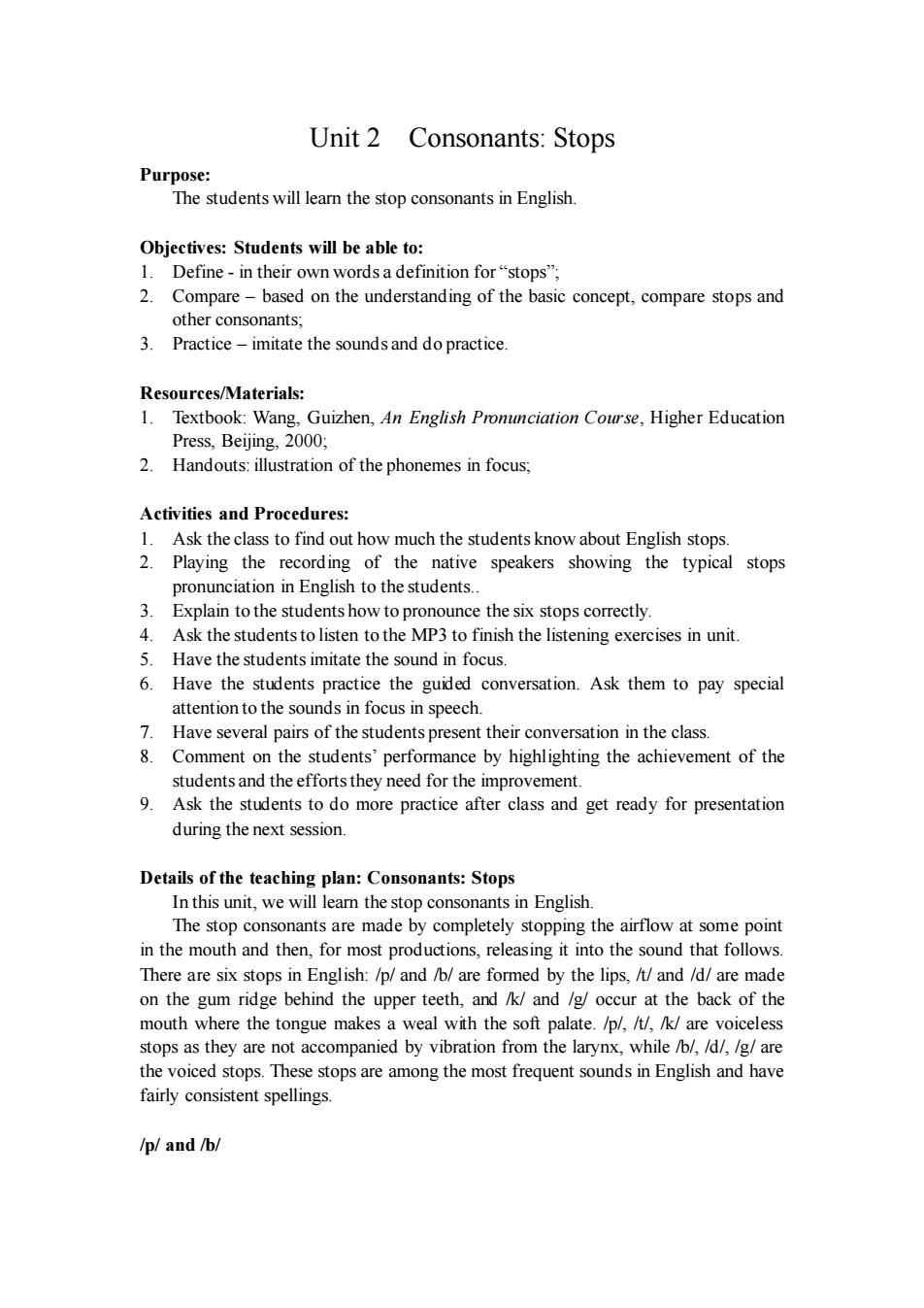正在加载图片...

Unit 2 Consonants:Stops Purpose: The students will learn the stop consonants in English. Objectives:Students will be able to: 2. Compare -based on the understanding of the basic concept,compare stops and other consonants, 3.Practice-imitate the soundsand do practice. Resources/materials 1. Guizhen,An English Promnciation Couse,Higher Education Press,Beijing.2000 2.Handouts:illustration of the phonemes in focus; Activities and Procedures: Ask the lass to find out how much the studentsknow about English stops 2. Playing the recording of the native speakers showing the typical stops pronunciation in English to the students. 3. Explain to the students how to pronounce the six stops correctly. 4.Ask the students to listen to the MP3 to finish the listening exercises in unit. Have the students imitate the sound in focus. 6. Have the st dents practice the guided conversation.Ask them to pay specia attention to the sounds in focus in speech. 7. Have several pairs of the students present their conversation in the class. 8 Comment on the students'performance by highlighting the achievement of the students and the efforts they need for the improvement. Ask the stude o more practice after class d s and get ready for presentation during the next session. Details of the teaching plan:Consonants:Stops In this unit.we will learn the stop consonants in English. The stop e made by completely sopping the in the mouth and then,for most productions,releasing it into the sound that follow There are six stops in English:/p/and /b/are formed by the lips,/t/and /d/are made on the gum ridge behind the upper teeth,and /k/and /g/occur at the back of the mouth where the tongue makes a weal with the soft palate./p/,/t/,/k/are voiceless stops as they are not accompanied by vibration from the larynx,while /b/,/d/,/g/are voiced stops.These stops are among the most frequent sounds in English and have fairly consistent spellings. /p/and /b/ Unit 2 Consonants: Stops Purpose: The students will learn the stop consonants in English. Objectives: Students will be able to: 1. Define - in their own words a definition for “stops”; 2. Compare – based on the understanding of the basic concept, compare stops and other consonants; 3. Practice – imitate the sounds and do practice. Resources/Materials: 1. Textbook: Wang, Guizhen, An English Pronunciation Course, Higher Education Press, Beijing, 2000; 2. Handouts: illustration of the phonemes in focus; Activities and Procedures: 1. Ask the class to find out how much the students know about English stops. 2. Playing the recording of the native speakers showing the typical stops pronunciation in English to the students. 3. Explain to the students how to pronounce the six stops correctly. 4. Ask the students to listen to the MP3 to finish the listening exercises in unit. 5. Have the students imitate the sound in focus. 6. Have the students practice the guided conversation. Ask them to pay special attention to the sounds in focus in speech. 7. Have several pairs of the students present their conversation in the class. 8. Comment on the students’ performance by highlighting the achievement of the students and the efforts they need for the improvement. 9. Ask the students to do more practice after class and get ready for presentation during the next session. Details of the teaching plan: Consonants: Stops In this unit, we will learn the stop consonants in English. The stop consonants are made by completely stopping the airflow at some point in the mouth and then, for most productions, releasing it into the sound that follows. There are six stops in English: /p/ and /b/ are formed by the lips, /t/ and /d/ are made on the gum ridge behind the upper teeth, and /k/ and /g/ occur at the back of the mouth where the tongue makes a weal with the soft palate. /p/, /t/, /k/ are voiceless stops as they are not accompanied by vibration from the larynx, while /b/, /d/, /g/ are the voiced stops. These stops are among the most frequent sounds in English and have fairly consistent spellings. /p/ and /b/